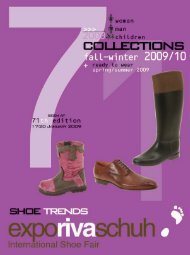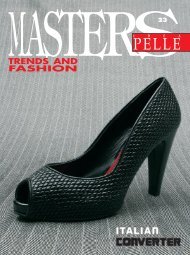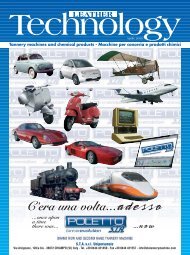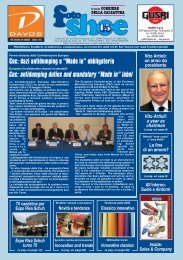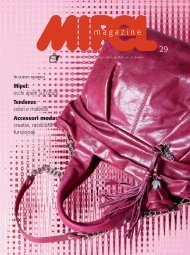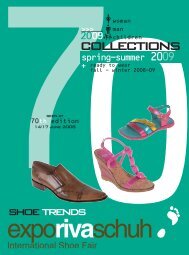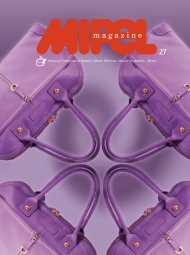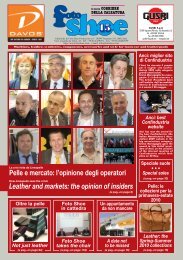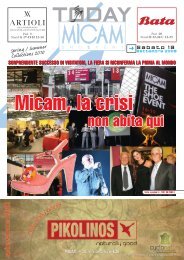Mercati finanziari contro l'economia reale Financial markets against ...
Mercati finanziari contro l'economia reale Financial markets against ...
Mercati finanziari contro l'economia reale Financial markets against ...
You also want an ePaper? Increase the reach of your titles
YUMPU automatically turns print PDFs into web optimized ePapers that Google loves.
Markets<br />
Il presidente di Indicam insiste: “Contro i falsi l’Europa faccia di più” - The Indicam president insists: “Europe must do more <strong>against</strong> fakes”<br />
I DATI DELL’ITALIA, I RISCHI E L’AUMENTO VERTIGINOSO<br />
Italy’s statistics, the risks and the soaring increase<br />
Contraffatti almeno 7<br />
prodotti su 100, ma per il<br />
tessile e la pelletteria la<br />
percentuale sale al 20<br />
“Passi avanti in Italia, ma<br />
l’Europa continua a sottovalutare<br />
il problema della contraffazione”.<br />
E’ questo il<br />
grido d’allarme lanciato da<br />
Carlo Guglielmi, presidente<br />
di Indicam, l’organismo che<br />
riunisce le industrie di marca<br />
produttrici di beni di consumo<br />
che vanno dall’alta<br />
gamma al largo consumo, le<br />
aziende fornitrici di servizi di<br />
anticontraffazione, gli studi<br />
di consulenza, e che opera<br />
all’evoluzione della legislazione<br />
in materia.<br />
Indicam, che ha sede a Milano,<br />
lavora a stretto contatto<br />
con la Magistratura, la Guardia<br />
di Finanza e la Direzione<br />
dell’Agenzia delle Dogane e<br />
sa bene come prolifera il<br />
mercato dei falsi. Lo sa così<br />
bene da fornire numeri,<br />
naturalmente indicativi, di<br />
un settore che per sua definizione<br />
è sommerso e che<br />
sfugge a qualsiasi catalogazione.<br />
Perchè l’industria<br />
della contraffazione non<br />
pubblica i propri bilanci.<br />
Tuttavia la rilevanza del<br />
fenomeno è valutata tra il 7<br />
e il 9% del commercio mondiale.<br />
Una ricerca dell’Ocse del<br />
2007 calcola in 200 miliardi<br />
di dollari i prodotti che<br />
hanno attraversato qualche<br />
frontiera tra il posto di produzione<br />
e il consumo, ma se<br />
si calcolano quelli che restano<br />
nella stessa area doganale,<br />
la cifra raddoppia.<br />
E’ falso il 20% circa degli<br />
articoli tessili, di abbigliamento<br />
e moda, il 25% degli<br />
audiovisivi e il 35% del<br />
software, mentre solo il 5%<br />
degli orologi risulta contraffatto.<br />
Ma il punto è che la<br />
produzione di falsi aumenta<br />
in modo vertiginoso: si stima<br />
che l’incremento mondiale<br />
della contraffazione dei prodotti<br />
negli ultimi 12 anni sia<br />
stata del 1850%.<br />
Oltre la metà dei tarocchi<br />
arriva dal Sud-est asiatico e<br />
circa il 60% di questi prodotti<br />
è destinato all’Europa. E’<br />
importante riflettere sul fatto<br />
che il 35% circa della produzione<br />
mondiale di falsi provenga<br />
dal bacino del Mediterraneo<br />
con destinazione<br />
Europa, Stati Uniti, Africa,<br />
Est Europeo; paesi leader<br />
L’Italia, la Spagna, la Turchia,<br />
il Marocco, ma sempre<br />
più spesso componenti di<br />
provenienza cinese arrivano<br />
in Italia attraverso altre<br />
dogane.<br />
Ma veniamo alle dimensioni<br />
del fenomeno in Italia. Il<br />
giro d’affari stimato è di 3,7<br />
miliardi di euro, il 60% dei<br />
quali realizzati con articoli<br />
falsi di moda, in particolare<br />
con articoli tessili, con la<br />
pelletteria e calzature.<br />
L’industria della contraffazione<br />
è diffusa in tutta la Penisola<br />
con punte elevate in<br />
Campania, Toscana, Lazio e<br />
Marche oltre al Nord est.<br />
Cosa manca Ben poco, e<br />
nessun sito industriale sembra<br />
essere escluso, ma il<br />
pericolo sociale più che<br />
economico sembra sfuggire,<br />
specialmente all’estero. Sì,<br />
perché - almeno per i falsi -<br />
pare proprio che la Politica<br />
italiana sia più attenta di altri<br />
Paesi europei.<br />
Guglielmi ha recentemente<br />
svolto una riflessione di<br />
grande rilevanza: “Il fatto<br />
che un incarico rilevante<br />
come quello del Commissario<br />
Europeo sia ricoperto da<br />
Mandelson che, di fatto, è<br />
portavoce degli interessi<br />
soprattutto di paesi più<br />
orientati al commercio che<br />
alla produzione, conferma<br />
una sensibilità al problema<br />
più apparente che <strong>reale</strong>”.<br />
At least 7 out of 100<br />
products are fakes, but the<br />
percentage for textiles and<br />
leather goods rises to 20.<br />
“Italy has made progress, but<br />
Europe continues to underestimate<br />
the imitation problem.”<br />
This is the alarm raised<br />
by Carlo Guglielmi, president<br />
of Indicam, the organisation<br />
that gathers together brand<br />
industries, manufacturers of<br />
consumer goods that go from<br />
high-range to mass consumption,<br />
companies supplying<br />
anti-imitation services and<br />
consultation studies, and<br />
that is working towards the<br />
development of legislation on<br />
this subject. Indicam, with its<br />
head office in Milan, works<br />
side by side with the magistracy,<br />
the Customs service<br />
and the Management of the<br />
Customs Agency and is well<br />
aware of how the imitation<br />
market is proliferating. In<br />
fact it can supply figures,<br />
indicative of course, for a<br />
sector that by definition is<br />
submerged and escapes any<br />
kind of classification;<br />
because the imitation industry<br />
doesn’t publish its balance-sheets.<br />
Nonetheless, the<br />
importance of the phenomenon<br />
is estimated between 7<br />
and 9% of world trade.<br />
Research carried out by Ocse<br />
in 2007 calculates 200 million<br />
dollars’ worth of products<br />
crossed some frontier or<br />
other from the place of production<br />
to the consumption.<br />
However, if products that<br />
remain in the same customs<br />
area are calculated, the figure<br />
doubles.<br />
About 20% of textile articles,<br />
clothing and fashion, 25% of<br />
TVs and hi-fis and 35% of<br />
software is fake, while only<br />
5% of watches are fake. The<br />
point is, that the production<br />
of fakes is soaring: it is estimated<br />
that imitation goods<br />
on a world scale over the last<br />
12 years has increased by<br />
1850%. More than half of the<br />
fake goods come from southeast<br />
Asia and about 60% of<br />
these products is destined for<br />
Europe: it is important to<br />
consider that about 35% of<br />
the world production of fakes<br />
comes from the Mediterranean<br />
basin with Europe,<br />
the United States, Africa and<br />
Eastern Europe as its destination.<br />
Which are the leading<br />
countries Italy, Spain,<br />
Turkey and Morocco but<br />
more and more often components<br />
from China arrive in<br />
Italy through other customs<br />
houses.<br />
But let’s get to the size of the<br />
phenomenon in Italy. The<br />
estimated volume of business<br />
is 3.7 billion Euros, 60% of<br />
which regards fake fashion<br />
articles, particularly textiles,<br />
leather goods and shoes. The<br />
imitation industry is evident<br />
throughout the Peninsular<br />
with high levels in the regions<br />
of Campania, Tuscany, Lazio<br />
and Le Marche as well as the<br />
North East. What’s missing<br />
Very little and no industrial<br />
site seems to be excluded, but<br />
the social danger rather than<br />
the economic one seem to go<br />
unnoticed, especially abroad.<br />
Yes, because – at least for the<br />
fakes - it seems that Italian<br />
policy is more attentive than<br />
other European countries.<br />
Guglielmi recently made a<br />
very important comment:<br />
“The fact that such an important<br />
appointment as European<br />
Commissioner was<br />
given to Mandelson who is<br />
above all, the spokesperson<br />
for the interests of countries<br />
aimed at trade rather than<br />
production, confirms a<br />
rather more apparent than<br />
real sensitivity to the problem.”<br />
FOTOSHOE15 28




